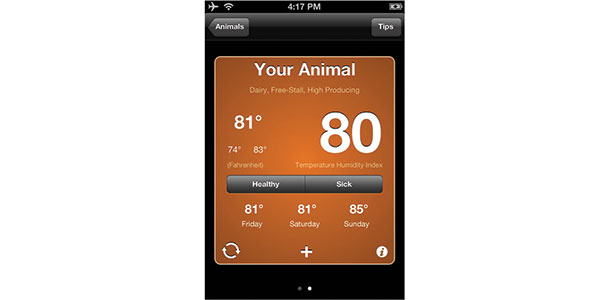The negative effects of heat stress are well known and documented on dairies today. Rising temperatures and humidity are associated with a decline in milk production and reproductive performance.
Solutions to minimize its effects are continually improving to better monitor cows through heat stress, and ultimately, help minimize its effects.

Assessing the cow
The technology available today to monitor the dairy cow’s response to hot weather provides producers with the knowledge they need to make decisions quickly. Some of these tools include:
Activity monitors
As activity monitors become more popular to detect estrus and early signs of disease, the technology also provides data related to how the cow is responding to heat stress.
Since heat stress reduces the length and intensity of estrus and increases the incidence of anestrous and silent ovulations, activity monitors can help identify cows in heat that may otherwise be missed.
Activity monitors can also be a valuable tool to assess the severity of the impact of heat stress on fertility. By evaluating activity, a producer could evaluate at what time and to what degree heat stress is occurring by monitoring when activity reduction occurs.
Data loggers
Tracking internal temperature of the cow can be done using a data logger, which is attached to a controlled internal drug release (CIDR) and can measure internal vaginal temperature for several days.
These devices can be placed in multiple cows across several pens to collect data every one to 15 minutes for a week or more. Once devices are removed, the data can be uploaded to a computer in a spreadsheet format and plotted on a graph to show internal temperature over time.
In studies, researchers have used data loggers to demonstrate how a cow’s core body temperature was lower when cooling devices were implemented compared to the use of stationary fans. The study was also able to correlate body temperature with standing behavior, with cattle more likely to stand above 102.07ºF core body temperature.
Data loggers can be a useful tool to help identify specific times and locations on a dairy where heat stress has a greater impact on the herd. This information allows producers to identify the microenvironments within their operation where adjustments are needed to keep cows cool throughout the day.
Reticulorumen bolus
Rumen temperatures have been used as an effective measure of core body temperature, and new technology uses active, electronic boluses to transmit data to a computer from the reticulorumen.
Studies have used the technology to assess changes in body temperature and provide accurate data that could be used by the dairy in improving their heat stress management strategies.
Keep in mind that drinking water can affect the temperature recorded by the bolus and should not be included in the overall calculation when assessing core body temperature. Also, because of the heat-producing rumen micro-organisms, ruminal and reticular temperatures are generally 32.9ºF greater than core body temperatures.
Assessing the environment
The other half of on-farm assessment is the environment in which the cow lives. Many tools can help assist in tracking the status of the animal’s environment and are now available in a new format – as phone apps.
Thermal Aid app
The Thermal Aid app provided by University of Missouri gives the temperature-humidity index (THI) for both beef and dairy cows using real-time automated input from local weather stations or manual entry of ambient temperature and humidity. Specific group information can be added and the THI will change accordingly.
As the THI changes, the color of the backdrop shifts through the four stages of stress – from no-stress (green) to emergency (red). Likewise, predicted daily THI values for the next week can be accessed.
Individual animal respiration rate can also be determined using the app for a more precise determination of thermal stress level. In every case, one can save the information and get basic tips to reduce heat stress levels.
Several other smartphone apps exist to manually calculate the THI for different livestock species. However, at the moment, none utilize real-time data entry.
Cool Cow app
The Cool Cow mobile app, provided by Purina Animal Nutrition LLC, puts the tools dairy producers need to monitor and address heat stress at their fingertips.
With the app, users will know when temperatures have reached levels that are stressful to the cow. This new tool is designed to assist dairy producers in mitigating the negative financial impacts of heat stress.
The mobile app features an easy-to-use heat stress calculator for inputting the current temperature and humidity readings. The temperature and humidity is then translated into a THI reading that shows the severity of heat stress, ranging from mild to extreme risk, providing dairy producers insight on the current conditions inside their barn.
In addition to the heat stress calculator, the mobile app offers tips on mitigating heat stress from management to nutrition.
The Cool Cow mobile app is available to download for Android phones and for iPhones .
Heat Stress in Livestock and Poultry app
The University of Guelph and the Ontario Ministry of Agriculture and Food and the Ministry of Rural Affairs have developed a free mobile app that calculates the level of heat stress.
The app allows producers to calculate heat stress based on the measured barn temperature and relative humidity. The resulting calculation shows the level of heat stress. It provides users with suggestions to reduce heat stress and improve animal comfort to help maintain feed intake and overall productivity.
Put these tools to use
Understanding the impact of heat stress on dairy farms is important when designing and implementing proper strategies to alleviate it. Many tools and technologies are available to help assess the severity of heat stress on the dairy, and it’s critical to use the information to evaluate where, when and to what severity animals are heat-stressed.
It may be overwhelming as data from multiple sources is provided related to heat stress, but this information allows you to actually monitor how your herd is responding to heat stress and when conditions have reached heat-stressed levels.
Producers should continue to work with consultants, companies and universities to properly implement and utilize new technologies to obtain the most value from their investment, improving overall profitability. PD
Todd Bilby has a Ph.D. in reproductive physiology from the University of Florida and is a dairy technical services manager for Merck Animal Health in Ft. Worth, Texas. He specializes in dairy reproduction, cow comfort and transition cow management.
References omitted due to space but available upon request. Click here to email an editor.
PHOTO: The Thermal Aid app provided by University of Missouri gives the temperature-humidity index (THI) for both beef and dairy cows.

-
Todd Bilby
- Dairy Technical Services Manager
- Merck Animal Health
- Email Todd Bilby









